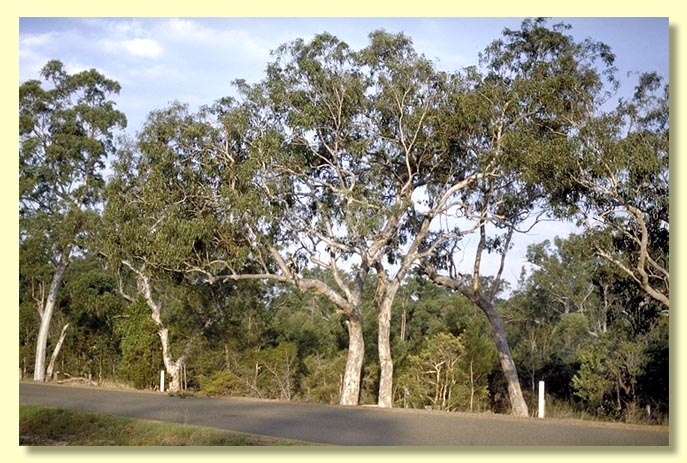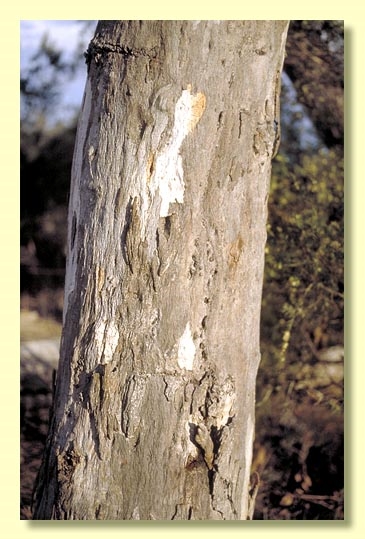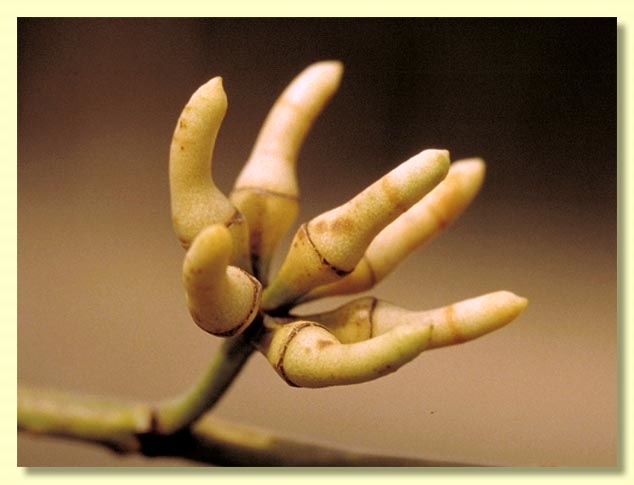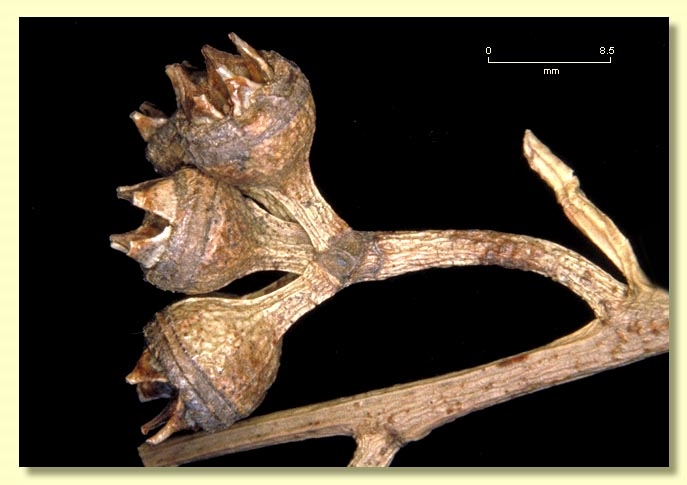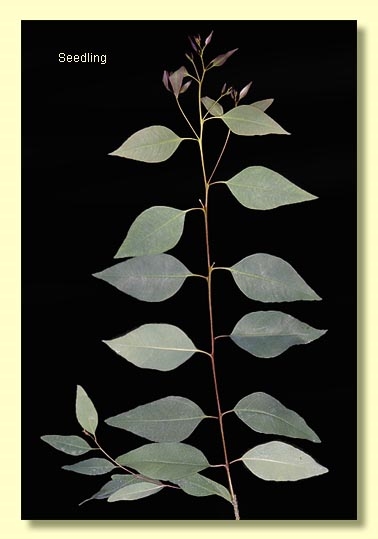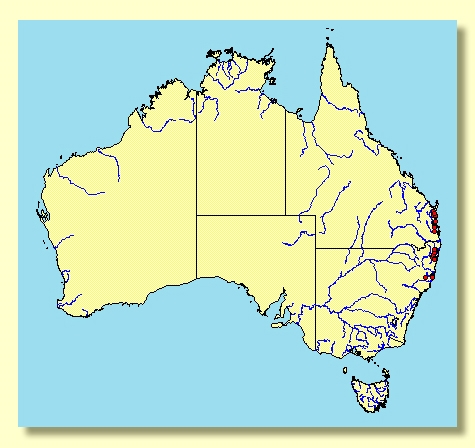Euclid - Online edition
Eucalyptus bancroftii
Eucalyptus | Symphyomyrtus | Liberivalvae
E. tereticornis var. bancroftii Maiden, Forest Fl. New South Wales 2: 9 (1904). T: Honeysuckle Flat, c. 9 miles [c. 15 km] S of Port Macquarie, NSW, July 1895, J.H.Maiden s.n.; lecto: NSW, fide J.H.Maiden, Crit. Revis. Eucalyptus 4: 14 (1917).
E. seeana var. constricta Blakely, Key Eucalypts 134 (1934). T: Burpengary, Qld, Dec. 1903, T.L.Bancroft s.n.; holo: NSW; iso: B.
Bark smooth, sometimes becoming granular with age, mottled white, grey, orange, pink or brown.
Juvenile growth (coppice or field seedlings to 50 cm): stem square in cross-section, sometime slightly winged; juvenile leaves petiolate, opposite for 5 or 6 pairs then alternate, ovate, 10–15 cm long, 3–7 cm wide, base tapering to petiole, green or grey-green.
Adult leaves alternate, petiole 1.7–4.8 cm long; blade broadly lanceolate to lanceolate or falcate, 10–26 cm long, 2–5 cm wide, base tapering to petiole or rarely oblique, concolorous, glossy or dull, green to blue-green or grey-green, side-veins greater than 45° to midrib, moderately to densely reticulate, intramarginal vein parallel to and well removed from margin, oil glands island.
Inflorescence axillary unbranched, peduncles 0.7–2 cm long, buds 7 to ?15, pedicellate (pedicels (0.3–0.6 cm long). Mature buds narrowly ovoid to oblong (1–2 cm long, 0.4–0.7 cm wide), green, creamy to red, smooth or faintly ridged longitudinally, scar present, operculum conical to horn-shaped (0.7–1.5 cm long), narrower than hypanthium, stamens erect, anthers cuboid to oblong, versatile, dorsifixed, dehiscing by longitudinal slits (non-confluent), style long, stigma blunt or tapered, locules 3 or 4, the placentae each with 6 or more vertical ovule rows. Flowers white.
Fruit pedicellate (pedicels 0.2–0.5 cm long), cup-shaped, obconical or hemispherical, 0.4–0.7 cm long, 0.6–0.9 cm wide, sometimes slightly ridged longitudinally, disc annular and raised above a prominent vertical inner operculum scar and free from valves, valves 3 or 4, strongly exserted.
Seeds brown, 0.9–1.3 mm long, pyramidal or cuboid, dorsal surface pitted, hilum terminal.
Cultivated seedlings (measured at ca node 10): cotyledons bilobed to oblong; stems square in cross-section, sometimes slightly winged; leaves always petiolate, opposite for 5 or 6 nodes, then alternate, ovate to lanceolate, 5.5–14 cm long, 2–5.5 cm wide, base tapering, green to grey-green.
Flowering has been recorded in November.
A small tree occurring in the coastal strip north from Kew near Port Macquarie in northern New South Wales to the Tin Can Bay – Boonooroo area just south-east of Maryborough in Queensland. It is usually of poor form and occupies infertile, sandy lowland sites. Eucalyptus bancroftii is characterised by smooth, often granular, white to grey to pink bark, relatively broad adult and juvenile leaves, buds with a long conical to horn-shaped operculum, often ending at the tip in a rounded blunt point, and by the hemispherical to cup-shaped fruit with an annular disc free from the ovary roof and strongly exserted valves.
E. bancroftii belongs to the group of red gums that is distinguished by having fruit with an annular disc and by brown (not black) toothed, single-coated, pyramidal seeds. There are four other species in this group— E. parramattensis, E. prava, E. seeana and E. interstans . E. prava is the closely related tableland form of E. bancroftii and differs by having more robust, normally glaucous buds and fruits and dull grey-green to blue-grey to glaucous adult leaves.E. parramattensis differs in having smaller buds with a shorter conical to rounded operculum. E. interstans and E. seeana have non-glaucous buds similar in size to E. bancroftii and differ by the narrower adult green leaves (normally narrower than 3 cm wide but usually wider than 3 cm in E. bancroftii ). E. seeana and E. interstans differ from each other by the juvenile leaves, which are narrowly lanceolate in E. seeana and ovate to broadly lanceolate in E. interstans.
Within its area of occurrence, E. bancroftii may be confused with other closely related, smooth-barked eucalypts, viz. E. tereticornis, E. amplifolia and E. hallii. E. tereticornis and E. amplifolia can be distinguished by having fruit with a steeply ascending disc that is fused to the remains of the ovary roof, unlike the annular disc of E. bancroftii that is free from the ovary roof. E. hallii can be easily distinguished by the obovoid buds with a rounded to bluntly acute operculum, unlike the relatively long narrow operculum of E. bancroftii.
The smooth granular bark of E. bancroftii can often resemble that of the unrelated grey gums (e.g. E. propinqua and E. punctata) from which it is easily distinguished by the concolorous leaves (grey gums always with distinctly discolorous adult leaves).

